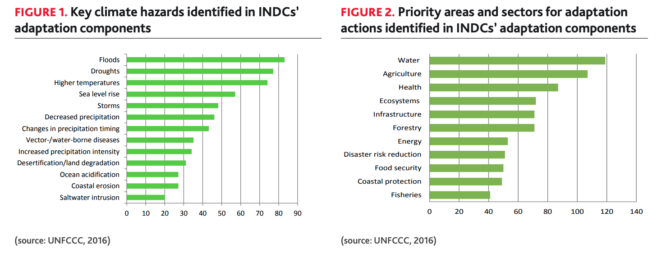Towards a Global Adaptation Progress Tracker: first thoughts

Introduction
Understanding whether we are on track to climate change adaptation at the global scale is critical to validate the “well below +2°C” mitigation target as a sustainable objective for humankind over the 21st century and beyond. In substance, the 2015 Paris Agreement suggests countries to be in charge of assessing and reporting their own adaptation progress, with then the United Nations Framework Convention on Climate Change (UNFCCC) helping with aggregating such efforts to provide a global-scale picture. Although many works have been developed to identify indicators and metrics for assessing national-level adaptation, no universal, agreed-upon framework has emerged to date that could be implemented in the coming years and allow feeding the UNFCCC Global Stocktake first round in 2023 with a global-scale assessment.
This working paper* proposes to measure adaptation progress directly at the global level through the development of new indicators and, when necessary, using new technologies. This approach —the Global Adaptation Progress Tracker (GAP-Track)— involves both scientific and political challenges in particular in terms of indicators, methods and implementation of the GAP-Track.
This paper argues that this approach, although not self-sufficient, could help stimulate international research on measuring progress in adaptation, and address some key challenges of the international climate negotiation process.
*This article is a summary of the working paper. Download the full report on the right-hand column for much more information.
Key Messages
- Answering the question ‘are we on track to adaptation at the global scale?’ is critical to validate that the “well below +2°C” mitigation target is sustainable for humankind over the 21st century.
- The usual approach to global adaptation tracking relies on the development of national-level indicators and frameworks to be developed by the Parties to the UNFCCC.
- Such an approach however raises political and diplomatic barriers (e.g. reluctance to report on national progress), as well as more technical concerns (e.g., not climate risks-specific indicators).
- A complementary, alternative approach consists of directly adopting a global-level perspective, based on the identification of metrics describing adaptation gaps/benefits directly at the global level. To this end, starting from the 8 key risks (i.e. of global importance) identified by the IPCC could help. They refer to key risks to people, landbased food security, ocean-based food security, water security, medium-to-large scale urban systems, functional networks, terrestrial biodiversity, and ocean biodiversity.
- This Working Paper describes the theoretical skeleton of a Global Adaptation Progress Tracker (GAP-Track) to inform UNFCCC climate negotiations with a scientifically robust, sound and relatively simple assessment of adaptation progress at the global level.
The Standard National Reporting Approach
The classical approach to track global adaptation progress relates to the development of country-level indicators reflecting the implementation of adaptation, both in terms of results and process.
Although there is currently no formal obligation for Parties to the UNFCCC to engage in such an assessment, the institutional process would benefit from the inclusion of a component on tracking adaptation progress into Nationally Determined Contributions (NDCs), National Adaptation Plans (NAPs) or National communications.
A country-level-driven assessment would also be best suited to fully consider national circumstances by using the context-relevant indicators.
However, some limitations must be recognized leading to a call for an alternative, complementary approach:
Political and diplomatic barriers:
- Diplomatic reluctances
- Outdated North/South divide
- Extra burden
- Latency in the negotiation process
Technical concerns:
- Not suited for a global perspective
- Missing future climate-related risk.
Four critical dimensions are considered in the design phase of the indicators:
- Target climate change-specific risks
- Contribution to adaptation rather than undisputed attribution to future risk reduction
- Reflect worldwide concerns in terms of risks from climate change
- Consider developing and developed countries together, not separately

Application:
A way to address the above dimensions consists of starting from identified worldwide key risks, as done in the IPCC Reasons for Concern framework and then associate global-scale indicators to each of them.
This paper proposes a four-phase approach that describes the skeleton of a Global Adaptation Progress Tracker (GAP-Track) to inform UNFCCC negotiations with a scientifically robust and sound assessment of adaptation progress at the global level.
- Phase 1: Identify key risks of worldwide concern
- Phase 2: Assess key risks-related benchmarks in the future
- Phase 3: Design relevant adaptation progress indicators
- Phase 4: Measure adaptation progress
Discussion: The Way Forward
The Narrative Challenge:
We still need a narrative at the global level to describe a common sense of what adaptation is, what our shared climate-specific targets are, how to reach them and at the end, what a global adaptation goal should be.
The PA actually provides limited insights on this as it refers to “enhancing adaptive capacity, strengthening resilience and reducing vulnerability to climate change, with a view to contributing to sustainable development” (Article 7.1).
Such a scope is too broad and relies on concepts that remain hard to conceptualise and measure in a uniform way. So that something more specific is needed.
The Indicator/Data Challenge:
There are concerns with using data availability as a starting point to define the nature of the indicators. For example, educational levels are informed through worldwide databases and usually involved in adaptive capacity assessments, assuming a positive correlation between education and adaptation. However, increasing examples challenge such a positive correlation, suggesting that educational levels are not necessarily the most suited proxy to describe adaptive capacity at work.
The Implementation Challenge
The last challenge refers to who should be in charge of implementing the Global Adaptation Progress Tracker and assess the state of global adaptation on a regularly basis. In the case of a standardised national reporting process, it is obvious that Parties must play this role, with the UNFCCC support. In the case of the GAP-Track, there is a need for an external-to-UNFCCC body to be in charge of the assessment. The implementing body or institution however needs to be sufficiently close to the UNFCCC arena to have an influence on climate negotiations.
The Intergovernmental Panel on Climate Change (IPCC), which is both politically neutral and scientifically credible, could play such a function. However, the IPCC is not necessarily equipped to drive the Global Adaptation Progress Tracker (e.g., lack of people and funds), and the development of new research (to design out-ofthe-box indicators) might go beyond its official mandate.
In parallel, the funding issue needs to be clarified: besides who can do it, how much will it cost and who should pay for it? As food-for-thought, maybe a percentage of the Global Environmental Facility (GEF) budget—and/or another international fund—could be dedicated to develop a Global Adaptation Progress Tracker.
Suggested Citation
Magnan, A. K., Chalastani, V. I. (2019). Towards a Global Adaptation Progress Tracker: first thoughts. IDDRI, Working Paper N°01/19.
(0) Comments
There is no content